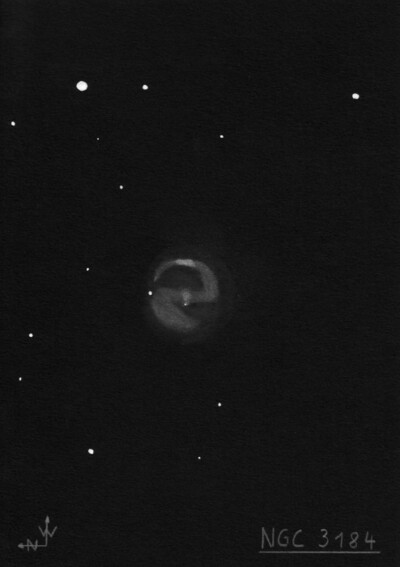
William Herschel discovered NGC 3184 = H I-168 = h688 = h689 on 18 Mar 1787 (sweep 716) and recorded "cB, R, near 8' dia, vgbM. A considerable star in the northern part of it but unconnected. John Herschel assigned two entries for this galaxy, h688 = H I-168 and h689, with the second entry a poor position for this face-on spiral.
Bindon Stoney, observing with LdR's 72" on 25 Jan 1851, logged "Is triple, neby perhaps extends round them all as far as the star north. h689 not seen." The following month, he commented "preceding part probably a portion of a ring." R.J. Mitchell sketched the the spiral structure on 1 Feb 1856 (fig 13, Plate XXVII in the 1861 publication). The sketch shows two brighter, elongated knots in the western arm and Dreyer catalogued these as NGC 3180 and 3181.
MCG mislabels the galaxy as NGC 3180.
400/500mm - 17.5" (4/4/92): fairly bright, large, slightly elongated ~N-S, large 4' halo has a fairly low surface brightness, very weak concentration, small brighter elongated core. There is an impression of spiral structure though it wasn't distinct. A mag 11.5 star is at the north edge of the halo 1.8' from the center. Located 40' W of Mu Ursa Majoris (V = 3.1).
900/1200mm - 48" (4/4/11): NGC 3184 is a beautiful face-on spiral with two main long arms and branches, along with several HII knots (two with NGC designations) in the arms. Contains a relatively small, very bright core, ~1' diameter with a sharp stellar nucleus. A mag 15-16 star is visible about 40" NE of the center near the edge of the core. One arm is attached on the east side of the core and winds counterclockwise around the south side of the core towards the west. The outer halo of the galaxy to the south of this arm has a much lower surface brightness. NGC 3181 is a bright, 15" knot (HII region/massive star cluster) embedded in this arm, 1.2' SW of the nucleus. The arm then continues spiraling outward as it heads north and contains NGC 3180, very small knot with a stellar core at 1.8' NW of the nucleus. This small knot is within a larger, slightly brighter portion of the arm. A second prominent arm is attached on the west side of the core and rotates counterclockwise around the north side towards the east. The surface brightness lowers on the east side and the arm splits into two branches. A mag 11.7 star is superimposed near the outer edge on the north side beyond the arm. Located 11' ESE of mag 6.6 HD 89053.
Notes by Steve Gottlieb